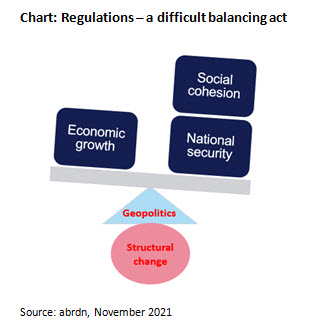Last year, Chinese policymakers stunned investors with a series of unexpected regulatory interventions that rocked the real estate, technology and private education sectors.
According to Bloomberg data, these actions wiped some $1 trillion off the market value of some of China’s most high profile and successful companies.
Analysts tried to make sense of these moves. Were they the actions of a government seeking to tighten its control over the country? Or were they legitimate attempts to tackle market competition issues, fix systemic risks and deal with concerns around growing social inequality?
What impact will recent regulatory changes have on China’s economy and society — the third in our series on regulations in China — looks at whether these actions are likely to address market failures, separating rhetoric from reality.
A stitch in time?
Impartially assessing the costs and benefits of regulation is difficult to do in developed markets (DMs), but it’s even more complex in an emerging market (EM), such as China.
Regulations may start further from "best practice," requiring firm action to address market failure (e.g., environmental damage) that can fester if left unchecked. However, decisive moves — with little due process or public consultation — risk offsetting benefits by raising policy uncertainty and market risk premia (the additional compensation investors demand for greater risk).
And while the whole economy and smaller firms may benefit from new regulations in the long run, the shock to large firms listed on stock markets is immediate and highly visible.
Policy evolution or revolution?
It’s undeniable that regulatory boundaries shifted aggressively and unexpectedly in 2021 — a clear move toward rapid action.
We cannot be certain whether these represent a step-change, motivated by one-off factors, or whether this is a more fundamental change in state involvement going forward. Many of the underlying reasons for taking action have been in place for some time.
But we can consider the changes on a case-by-case basis and assess whether these actions are likely to achieve high-level policy goals, for example whether they will reduce systemic risks and tackle competition issues.
We can consider the changes on a case-by-case basis and assess whether these actions are likely to achieve high-level policy goals
Reducing property sector risks isn’t without danger
Real estate has played a big part in China’s economic growth and development. The sector’s role as a source of financial vulnerability has also been known for some time.
Measures to reduce property risks have focused on limiting the amount of debt that developers take on, as well as the amount that banks can lend to developers and property buyers. These are clearly measures that should reduce risks in the long run.
Of course, the act of applying constraints on the sector could trigger the very instability that policymakers are keen to avoid — just look at the problems caused by the China Evergrande Group, one of China’s biggest and most indebted developers.
Technology at the intersection of innovation, power and politics
The acceleration of digitization brought about by the Covid-19 pandemic boosted stock prices, and showed how the big tech firms had become critical to both the economy and society.
Chinese authorities were already re-considering how much latitude powerful technology firms should enjoy. This likely gave more urgency to regulatory actions.
Fintech may bring innovation and financial inclusion, but as the dividing line between technology and finance became increasingly blurred, the risk of regulatory arbitrage — companies evading oversight that governs banks — became too big to ignore.
"Big tech" isn’t just a Chinese problem. More and more governments feel uncomfortable with a "winner- takes-most" business landscape that’s dominated by a few large firms.
Amid deteriorating US-China relations, there’s also a national security dimension to data flows, which are becoming an integral part of economic life.

Education — less is more?
Unlike property and big tech, the effective shutdown of the private education sector wasn’t a market failure issue. But when viewed through the prism of "common prosperity," it can be seen as an attempt to resolve a social failure.
That’s because many parents were caught in a debilitating education arms race as they sought to give their children the best start in life.
However, there are reasons to doubt whether these actions will fix the underlying problem. Wealthier families will still be able to secure one-on-one tutoring services, while access to the most prestigious universities still favors the rich.
Common prosperity — is more intervention less market friendly?
Overall, we do not believe that the actions of regulators in 2021 solely reflect a reassertion of the state — there are genuine reasons for intervention, even if in some situations reality may not quite match the rhetoric.
But they do raise further questions about the authorities’ willingness to intervene in other industries for social purposes. And these actions are a reminder that the opacity of the decision-making process in China can result in sudden shifts in regulatory boundaries.
IMPORTANT INFORMATION
Foreign securities are more volatile, harder to price and less liquid than U.S. securities. They are subject to different accounting and regulatory standards, and political and economic risks. These risks are enhanced in emerging markets countries.
Companies mentioned for illustrative purposes only and should not be taken as a recommendation to buy or sell any security. It should not be assumed that recommendations made in the future will be profitable or will equal the performance of the securities in this list.
US-240522-175428-1

